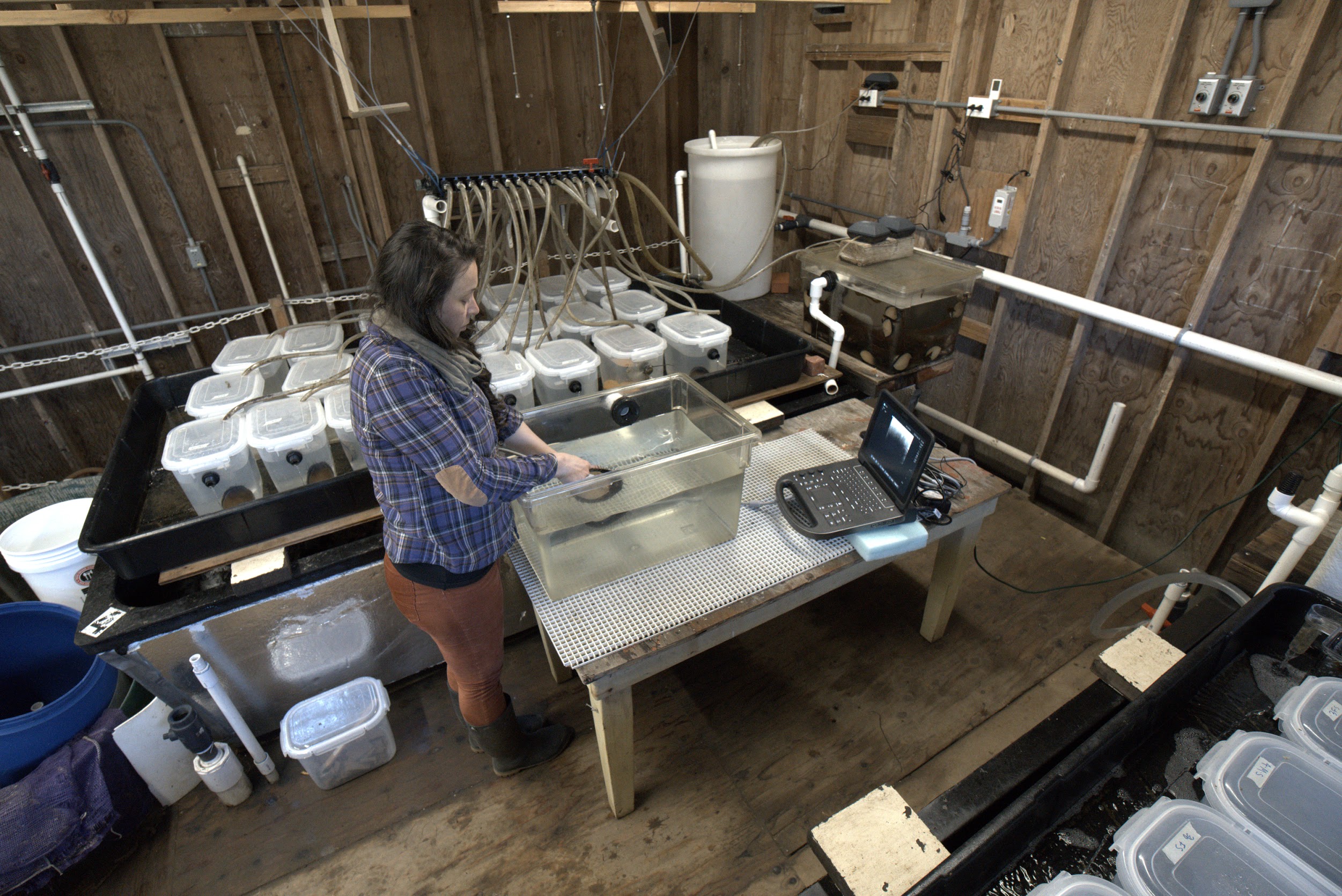创新背景
鲍鱼几乎在地球的每个角落都受到威胁:濒临灭绝或在一些方面很脆弱。虽然一些物种正在进行圈养繁殖,但这些巨大的海螺产卵是出了名的困难。
创新过程
由于黑鲍鱼数量少,易受伤害程度高,作者利用养殖近缘的红鲍鱼来测试超声波对鲍鱼的检测效果。
格罗斯曾用这项技术对鲟鱼和鲶鱼的性腺进行评估,但在这项研究之前,它从未对海螺进行过测试。当格罗斯看到一段苏格兰兽医对一只大蜗牛进行超声波检查的视频时,他确信这对鲍鱼也适用。

有了Gross的背景,在UC Davis Bodega海洋实验室的白鲍鱼圈养繁殖项目的广泛知识,以及第一作者Sara Boles研究红鲍鱼的经验,研究人员在12只农场饲养的红鲍鱼和大约100只在Bodega海洋实验室饲养的红鲍鱼上测试了该方法。他们对实验室饲养的鲍鱼进行了7周的监测,以检测它们性腺大小的季节性变化。
他们发现超声波可以区分生殖组织和消化组织。然后,他们能够建立一个从1到5的性腺指数得分,以表明鲍鱼的繁殖准备程度。3到5的鲍鱼是产卵的理想选择。他们还发现,这项技术足够敏感,可以检测到产卵前后的变化。

那么如何用超声波检查鲍鱼呢?将鲍鱼放入水族箱中,然后将超声波换能器放在水族箱的外侧,就在鲍鱼的脚边。声音通过水箱并传送图像。
使用超声波的常规评估可以在完全不接触动物的情况下进行。鲍鱼产卵时仍然需要处理,但超声波可以将处理过程降到最低。
创新价值
这项技术有望帮助鲍鱼养殖户和圈养养殖管理者生产更多的鲍鱼,对种群管理者在选择产卵季节的个体时非常有帮助,同时减少对动物的压力。
创新关键点
研究人员发现超声波可以区分生殖组织和消化组织。然后,他们能够创建一个性腺指数得分,范围从1到5,表明鲍鱼准备繁殖。在3到5个范围内测量的鲍鱼可能是理想的产卵候选者。他们还发现,这项技术足够灵敏,可以检测到产卵前后的变化。
Using ultrasound to help endangered abalone spawn
Due to the small number and high vulnerability of black abalone, the authors used cultured red abalone, a close relative, to test the effect of ultrasonic detection on abalone.
Gross has used the technique to evaluate the gonads of sturgeon and catfish, but until this study it had never been tested on conch snails. When Gross saw a video of a Scottish vet performing an ultrasound on a large snail, he was convinced it would work for abalone.
With Gross's background, extensive knowledge of the white abalone captive breeding program at UC Davis Bodega Marine Laboratory, and first author Sara Boles' experience working with red abalone, The researchers tested the method on 12 farm-raised red abalone and about 100 red abalone reared at the Bodega Marine Laboratory. They monitored lab-reared abalone for seven weeks to detect seasonal changes in their gonad size.
They found that ultrasound could distinguish between reproductive tissue and digestive tissue. They were then able to establish a gonadal index score on a scale of 1 to 5 to indicate the reproductive readiness of the abalone. Abalone of 3 to 5 are ideal for spawning. They also found that the technique was sensitive enough to detect changes before and after spawning.
So how do you ultrasound an abalone? Place the abalone in the aquarium, then place the ultrasonic transducer on the outside of the aquarium, just at the abalone's feet. Sound passes through the tank and images are transmitted.
Routine assessments using ultrasound can be performed without contact with animals at all. Abalone still needs to be handled when they spawn, but ultrasound can minimize that.
智能推荐
AI+农业 | 农业拖拉机电气化趋势
2022-08-17探讨无化石农业的发展路径,以电气取代农业机器对化石燃料的依赖。
涉及学科涉及领域研究方向一种隔离血红素的植物肽促进共生细菌的铁摄取
2022-08-14麻省理工的一项研究发现了豆科植物细胞中具有一种会吸收所有可用的血红素的多肽——NCR247。这种多肽被豆科植物用来控制固氮细菌,同时它也可能对治疗血液中血红素过多的患者有益处。清除血液中的游离血红素有助于治疗由需要血红素生存的细菌或寄生虫引起的疾病,如牙龈杆菌(牙周病)或弓形虫病,或向血液中释放过多血红素的镰状细胞病或败血症等疾病。此外,这项研究也表明了,植物和微生物相互作用的基础研究也有可能转化为治疗应用。
涉及学科涉及领域研究方向利用可生物降解的地膜替代塑料薄膜
2022-08-17研究开发可降解的农用覆盖地膜,保证农业高质量发展的同时降低对环境的影响,可持续发展农业。
涉及学科涉及领域研究方向C4和CAM循环的共同作用有助于打造抗旱高产植物
2022-08-15耶鲁大学的研究团队通过对马齿苋叶片内的基因表达进行分析发现,C4和CAM活性在马齿苋中是完全整合的,两种途径在相同的细胞中运作,为植物提供强力的保护。了解这一新的代谢途径可以帮助科学家设计出新的方法来改造玉米等作物,以帮助植物抵御长时间的干旱。
涉及学科涉及领域研究方向